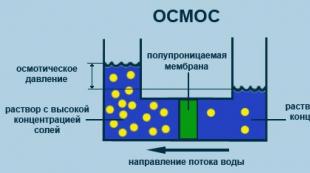Complement questions of indirect cases. What questions does the add-on answer? Theory, examples. What is the name of the definition for which the type of syntactic relationship between the main and dependent word is agreement
ADDITION(tracing paper from French complément or German Ergänzung), a minor member of a sentence that fills in the non-subject valency of a predicate word.
The concept of complement was developed by French encyclopedists in the middle of the 18th century. In the domestic tradition, a similar term "filling" was used in the grammar of M.V. Lomonosov (1755) to denote a semantic function, for example, the word sky in the example The clouds covered sky ; but to denote additions in the grammar of A.A. Barsov (1783–1788), the term "controlled" was used (a copy of the French term régime "control // controlled", used in the grammar of Port-Royal 1660 - sometimes to designate not only the very relations of control, but also of its second member - "controlled", ie complement). The term "controlled" then entered the Academic Grammar of 1802 (D. and P. Sokolovs) and was subsequently used by various authors alongside or instead of the term "addition".
The term "addition" appeared in the work of N.I. Grech (1827) and has since come into use (although the very expediency of this concept was then repeatedly questioned - for example, A.M. Peshkovsky, who, following Barsov, preferred to speak only about " managed members "). At first, circumstances were included in the number of additions (this is the concept of I.I. Davydov, 1852). F.I.Buslaev (1858) proposed to take the circumstances beyond the scope of additions, and this last point of view eventually prevailed.
The complement is a syntactically controlled member of the sentence - its position and design are controlled by the predicate word (in case languages, the predicate determines the choice of case or prepositional-case form in which the complement stands); in languages with object agreement, the complement is the controller (or one of the controllers) of the predicate agreement; Some theorists of ergativity, following I.I. Meshchaninov, believe that in such languages the direct object is the third main term of the sentence.
The addition can control the agreement of the significant part of the analytical verb form of the predicate (by gender and number) in some constructions such as French phrases with the preposition of a significant addition to the relative clause: les mesures qu "on a prises"The measures that have been taken" la lettre qu "il a écrite n" est pas arrivée"The letter he wrote did not arrive."
Unlike "weakly controlled" (adverbial) modifiers, which are usually attributed to circumstances, the addition is a syntactic actant, i.e. fills in the obligatory predicate valency (and is thus a "strongly controlled" member); from the point of view of predicate-argument logic, a complement corresponds to one of the arguments of a multiplace predicate (namely, a semantic object). Therefore, for example, steps v Petya walks with brisk steps is considered not an addition, but a circumstance (it answers not the question "what?", but the question "how?" and is equivalent to an adverb quickly).
Additions are similar in a number of respects to the subject. The hypertrophy of this similarity causes some supporters of the verbocentric interpretation of the sentence (inspired by the logical and mathematical concepts of the 20th century, where the focus is on the multiplace propositional form - a predicate with several of its arguments) the desire to completely abandon the difference between additions and the subject in favor of a single concept, as whatever it is called ("actant", "complement" // "addition" or "predicandum"). However, this approach has not received recognition in linguistics. With all three interpretations of a sentence widespread in science (bicentric, verbocentric, or nominativecentric), the addition is interpreted as a component of the predicate composition.
By their structure, the following types of add-ons are distinguished:
(1) simple (expressed by a proper name, an actualized group of a common noun and an actualizer or a pronoun);
(2) analytical, expressed by a combination of an official word (preposition or postposition) with a significant one; usually indirect additions are designed like this: hope for success; but, for example, in Spanish, a direct addition can be formalized with a prepositional group, if a proper name acts in this role: cf. El mismo ensillу a Rocinante"The same man saddled Rossinant";
(3) combined, including composed, for example, Misha introduced Petya and Vanya(together);Misha introduced Petya to Vanya; Misha introduced Petya to Vanya;
(4) complex, including: subordinate-nexus infinitive ( made the aggressor get away, puto Carthaginem delendam esse"I believe that Carthage must be destroyed"); subordinate-nexus incoherent ( consider Chomsky a founder), including with "double accusative" (lat. Romani appellarunt Ciceronem patrem patriae"The Romans called Cicero the father of the fatherland"; I found him surrounded by our officers; st.- sl. make Methodius a bishop); subordinate-nexus gerundial ( I heard Mary singing); Sentential (that is, expressed by a subordinate clause), including an explanatory one, in which subordinate unions are a formal indicator of a complementary role what and to(cf. He believed that his friends were ready / For his honor to take the shackles).
A complement can be semantically redundant if it repeats the meaning of the predicate (the so-called figura etymologica: live your life, walk etc.); in this case, the main semantic load is assumed by the definition to the addition ( live a hard life, walk awkwardly).
For verbs with an object object, the latter expresses a reduced (nominalized) predication (with the meaning of a fact, situation or proposition). These are verbs with phasic, modal, interspecific, perceptual, mental and propositive meanings. A non-objective addition is canonically expressed by a subordinate clause, an explanatory, infinitive turnover, a predicate name or an non-objective pronoun ( this, what, something ...).
Usually the verb agrees with its object in some categorical properties. The semantic inconsistency of the verb with the object is a sign that a semantic shift has occurred. So, a specific addition with an abstract verb means that the addition should be understood metonymically ( I hope for Petya means "I hope for Petya's actions"; I'm waiting for Dima means "I'm waiting for Dima to come"). An abstract addition for a specific verb most often means that the combination as a whole should be understood in a figurative sense, for example, metaphorically ( talk nonsense, pick up an idea etc.). Often, a mismatch requires restoring the semantic gap: feel cold metal means, most likely, "feel the touch of cold metal."
If several additions are possible for a given verb, then some hierarchy is usually revealed among them. As a rule, one of the additions is more important than the others, has the highest communicative rank (expresses "direct object"). This priority is manifested in many ways; Most languages have their own set of formal properties (typical case, typical linear position relative to the predicate, typical concordant role indicator in the composition of the predicate, etc.), which is characteristic of the complement with a double verb. A complement that has this set of properties is called direct; the rest of the additions are called indirect.
If a predicate controls a single complement, then most often it is direct complement. However, for some (so-called "indirect transitional") predicates with rigidly fixed diathesis, the only addition is indirect: cf. obey who / what, depend on what, help whom, follow what(for whom), equal to what, to lead what etc.
In case languages, the main feature that distinguishes direct objects from indirect objects is case. In accusative languages (including Russian), the direct object case is the accusative non-sentence; in ergative languages - the absolute nominative case. The symptom of a case is considered to be diagnostic for a direct addition.
From this, however, it does not follow that the accusative non-sentence always expresses the direct object: for example, in constructions like Kiss the night read accusative non-sentence expresses an indirect addition (or, according to another classification, "circumstance") of duration (length of time) and answers the question " how long?for how long? ". In constructs like The suitcase weighs ten kilograms accusative quantitative group ten kilograms expresses not an object, but a measure of a parameter and therefore answers not the question "what?", but the question "how much?"; at the same time, it differs from typical circumstances by filling in the obligatory valence of the predicate, while at the same time it is expressed by the non-sentence accusative.
In languages with a rigid word order, there are more or less strict rules for the arrangement of direct and indirect object relative to the predicate. So, in Chinese, English, French, German, the direct object is placed after the predicate; in such cases, postposition is a diagnostic sign of complement. In the Altai languages, the direct object is, on the contrary, in front of the predicate.
In languages with a rigid word order, the inversion of the complement (its movement from its usual place) is sometimes possible, but it rarely occurs and at the same time has a pronounced character of a specialized signal with a modal or emphatic meaning. However, even where the word order is not rigid, one of the possible word order is dominant. Therefore, sentences like Being determines consciousness; Mother loves daughter; Truck pulls a tractor in the absence of communicative hindrances, they are normally perceived unambiguously: as sentences with the order "subject - predicate - addition"; respectively, nouns consciousness, daughter, tractor in these phrases, they are usually perceived as taking the position of a direct object. Since the direct object in the dominant word order is closer to the verb than the indirect object, phrases like I prefer metro taxis are far more likely to be understood as meaning “I prefer metro to taxi” than vice versa.
In languages that have a passive voice, a typical sign of a direct object is the ability to transform a passive construct into a subject. However, occasionally it turns out that the passive transformation is admissible by the non-accusative complement ( Ivanov runs a plant - a plant run by Ivanov); there are also direct additions that do not allow passivization (* Petya thanks Vanya, *The dacha is owned by Alla).
The main structural function of the direct object is to replenish the second syntactic valence of the transient predicate.
Like other members of the proposal, the add-on is characterized by polyfunctionality. The main semantic function of direct complement is the expression of the semantic direct object ( cm... AN OBJECT) . About secondary semantic functions, realized in indirect diathesis, cm... DIATHESIS.
Indirect additions are classified in both function and form. They are subdivided into several formal-semantic types (each of which is characterized by its own typical means of expression and a typical set of functions, of which usually one is a canonical function). In multi-reliable languages, indirect object types are expressed in special cases and prepositional-case forms; in unreliable and unreliable analytical languages, along with prepositions and postpositions, a significant role is played by the linear arrangement of the additions relative to the verb and relative to each other; in concordant languages with object concordance, the marking of roles in the verb word form with special affixes acquires a special role. In prepositional unreliable languages, the direct object is non-propositional, and the indirect ones are most often prepositional; however, occasionally the indirect object is also formed without a suggestion, like in English verbs like give"give".
The most important types of indirect augmentation are targeted and instrumental-agent.
In its primary function, the addressee designates the recipient of property or information ( give to husband, tell mom); a kind of addressee is beneficial ( for wife), and in languages with dominant affective construction - also experimental ( she liked novels early).
Instrumental-agentive (or simply “instrumental” in a broad sense) addition has several functional varieties: actually instrumental // instrumental (expressed by a semantically inanimate name in instrumental diathesis: to sew with a needle) and agentive (expressed by an animate name in a passive indirect-agentive diathesis: tailored). On many grounds (first of all, on the basis of facultativeness), the instrumental-agentive addition is close to the circumstance, which gives reason to see here a "circumstantial addition" or "instrumental circumstance".
The criterion for distinguishing indirect additions from circumstances and from definitions is usually the question asked. Indirect additions answer indirectly case (and not adjective or adverbial) questions. So, the phrase He fell in love with this city answers the question "What did he fall in love with?" (there is an indirect addition), and He came to this city- to the question "Where did he come?" (the circumstance of the final point is evident).
Another criterion for distinguishing a complement from other members of a sentence is anaphoric pronominalization. In the example Do you like cheese?- asked the prude once. - I love: - he answered, - I find a taste in him(K. Prutkov) an indirect object is expressed by a substantive pronoun ( in him). Meanwhile, the circumstance of the place does not allow such a pronominalization, which explains the comic effect of the comic poem by Dm. Shmeleva: Do you love the forest?- asked the prude once. - I love: - he answered, - I find mushrooms in him... Adverbial pronoun substitution ( there) would eliminate this comic.
Some languages allow such a transformation in which the direct complement of one diathesis corresponds to the indirect complement of another, and vice versa. So, in a donative construction like The tsar granted Ermak a fur coat direct addition fur coat expresses the role of the transferred property, and the indirect addition Ermak expresses the role of the recipient; meanwhile, in the decorative (rewarding) design of the type The tsar granted Ermak a fur coat direct addition Ermak expresses the role of the recipient, and the indirect complement fur coat expresses the role of the transferred property. In the presence of such a diathetic transformation in a number of languages, the possibility of passivation turns out to be a property of more than one participant in the situation, cf. English John gave her a book® She was given a book(by John) (the recipient's direct complement is passivated here); and John gave a book to her® A book was given to her by John(here the direct addition of property is passivated).
Depending on the categorical affiliation of the governing predicate word, the additions are subdivided into adjectives and adjectives. A number of verbs (the so-called verbs of incomplete predication) do not allow the omission of the object or are radically rethought with such an omission: have, make, lay down, take, to want, give, put, carry, to grab etc. Unlike adjectives, adjectives almost always behave indirectly and are treated accordingly. The only exception is direct addition for some types of non-verbal predicatives (statives): you can see the mountain, sorry for the bird etc.
The adopted additions differ from the verbal ones in their lesser obligation and transformation of the case formulation: cf. subjective ( devoted to his wife, attached to his wife, in love with a wife) and intrinsic ( love for wife). Therefore, they are always classified as indirect.
An adjective addition denotes a restriction of a feature in one way or another. The second term of some relation ( far from Moscow), the type of the parameter characterized by this feature ( good taste etc.), subject aspect ( strong in spirit, weak in body) etc. Comparative complement means the second term of comparison ( above the pine), i.e. another bearer of the feature - the subject ( Tanya loves music more than her sister // more than her sister), compliant ( Tanya loves mathematics more music // more than music), another feature ( Vasya is more simple-minded than kind), another time ( You are more right than ever before). Adverbial additions are highlighted by grammarians in cases where the complemented term is interpreted as an adverb. However, in all such cases, an adverb can also receive a different categorical interpretation: as a derived adverbial preposition ( regardless of mother) or as a derivative of the adjective pronoun numeral // quantitative pronoun ( a lot of worries, little time, a few rubles, how many bottles etc.). However, for example, an adverb with a comparative meaning ( same way(how)) requires filling in the second valency with the name of the second comparison term: work as good as Stakhanov; Wed parallel complement work better than Stakhanov.
Substantive additions are made out:
(a) inherent unsubstantiated genitive ( Lermontov's murder); possessives, i.e. possessive adjectives and pronouns ( your arrival, your leaving); other transformed forms ( love to motherland);
(b) indirectly complementary non-transformed forms, directly corresponding to the forms of indirect adjectives ( striving for truth, fighting classicism ...);
(c) the transformed ergative (agentive-instrumental) form of the instrumental case, used in a similar way to the indirect complement of the agent ( beating of babies by Herod, abduction of a goose by Panikovsky).
Many types of intrinsic additions are sometimes interpreted as definitions, for which there are good reasons: very often they answer the question "whose? Which?" (along with the questions "what?", "whom?", "to whom?", "with whom?", indicating the role of direct complement).
One of the fruits of the endless discussion about the applicability of the question test in parsing was the realization that in such cases, there is a combination of completeness with attributiveness.
The canonical morphological-syntactic form of direct object is the accusative non-sentence case of a noun or pronoun. In an incomplete sentence ( Carriage to me, carriage!) such a form is a representative of the entire predicate group, even in the absence of a complemented member; the same happens for ellipsis ( To whom - brandy, and to whom - cranberry tincture). However, under the conditions of morphological-syntactic transposition, a non-specialized form appears in the position of direct object:
(a) accusative non-sentence of the substantive adjective ( scolding late), substantive numeral ( add ten), substantive adverb ( we build a wonderful tomorrow, destroy the damned yesterday), elective construction ( met one of the girls, singled out one of the strongest);
(b) the quantifier group ( earns little money, wrote several articles, gave all the children an apple, two apples, ten apples);
(c) infinitive turnover ( ordered to remove, asked to meet).
The infinitive object is typical for many verbs with modal ( want), phase ( start), perceptual (lat. video ...), mental (lat. puto ...), dictal (lat. dico ...), directive ( I order ...), causative ( forcing ...) and some similar value types.
The morphologized addition in many languages has a number of important side semantic loads. So, in Slavic languages, the accusative form in this position expresses explicitly the opposition of names by animate / inanimate (in Russian - for names in the plural, as well as for masculine names). The syntactic alternation of the genitive with the accusative allowed in this position participates in the expression of the referential and definite name. The syntactic alternation of the partitive (or genitive) with the accusative allowed in this position expresses the partial / integrity of the material object ( brought pies- brought pies ).
Sergey Krylov
Literature:
Espersen O. Philosophy of grammar... M., 1958
Apresyan Yu.D. Experimental study of the semantics of the Russian verb... M., 1967
Alisova T.B. Essays on the syntax of the modern Italian language... M., 1971
Arutyunova N.D. The proposal and its meaning... M., 1976
Lions J. Introduction to Theoretical Linguistics... M., 1978
Katsnelson S.D. (editor-in-chief). Category of subject and object in languages different types
... L., 1982
Kibrik A.E. (ed.) New in foreign linguistics. Issue 11. Modern syntactic theories. M., 1982
Gak V.G. Russian versus French, ed. 2nd. M., 1988
Vardul I.F. (editor-in-chief). Essays on the typology of word order... M., 1989
Apresyan Yu.D. Lexical semantics. Synonymous language means... M., 1995
Arutyunova N.D. Human language and world... M., 1998
Gak V.G. Theoretical grammar of the French language... M., 2000
Peshkovsky A.M. Russian syntax in scientific coverage, ed. 7. M., 1956 [reprint: M., Editorial URSS, 2001]
Minor members play an important role in the sentence, enriching it, bringing clarity, clarifying the subject and predicate. Among them, the addition stands out. The mistake in highlighting this minor term is that it is often confused with the subject, especially when it is in the accusative case. In order to avoid inaccuracies, you need to know what questions the add-on answers. We will talk about this in the article.
General information
The supplement answers the questions of indirect cases. These include everything except the nominative (the subject answers to it).
Usually, a question is asked to the addition from the members of the sentence (secondary and main), which are expressed either by verbs or close in meaning to them (participles, gerunds).
Meaning
Complement values can be completely different. Let's analyze such a relationship with the predicate in the sentence and see how the addition answers the questions. See examples below.
Olga does (what?) An injection.
Olga gives an injection (to whom?) To her mother.
Olga injects (what?) With a syringe.
Sometimes there are additions depending on verbal nouns and adjectives: conquering the top, moving to the end of the formation, fish fried in a pan.
If you organize the meanings, taking into account what the complement responds to, you get the following:
- This minor term defines an object that experiences an action on itself: choose (what?) A profession, wash (what?) Clothes.
- The subject in the interests of which the action is being performed: write to your brother, approach your sister, visit your parents.
- A means of performing an action or an instrument of labor: write with a pen, swim breaststroke, paint with a brush and paints.
How is the addition expressed?
The addition, like the subject, is expressed by the following parts of speech:
- A noun in the form of an indirect case or a pronoun-noun in the same form. At the same time, the preposition is variable: I went (to whom?) To my mother; happy with (what?) work; I am thinking (about whom?) about him; bring (whom?) him.
- Any substantive part of speech (endowed with the function of a noun). Everyone was interested (by whom?) In the readers.
- Infinitive. The audience asked the troupe (about what?) To dance again.
- By a numeral name. I'll multiply (what?) Fifteen (what?) By ten.
- Phraseologism. I ask my sister (about what?) Not to hang her nose.

What does the addition refer to?
Since the addition answers the questions of indirect cases, it most often refers to the predicate verb. Thus, it clarifies the main action reported in the proposal. We walk (with whom?) With my daughter around the store. In this case, the addition "with a daughter" spreads the predicate verb "walk".

However, this minor term can also refer to a noun that has an action in its meaning. For example, "He is the driver (what?) Of a heavy truck." The addendum "car" refers to the noun "driver".
Short adjectives are close in form and meaning to the predicate verb, therefore this minor member can also apply to them: I am angry (at whom?) At my neighbor. The addition with the preposition "to the neighbor" refers to the short adjective "evil." Less commonly, it refers to the full adjective: Similar (to whom?) To the father.
Often, the addition explains an adverb or an adjective in a comparative degree. For example: She looks younger (what?) Her age. Jasmine is more aromatic (what?) Than a rose.
Direct
Depending on what questions the addition answers, it can be either direct or indirect. The first requires setting in the accusative case, and there can be no preposition with it.
This addition defines the object of the action. It refers to a transitive verb or adverb. For example: to hate the enemy is direct, stands in the accusative case, and the verb "to hate" is transitive. Another example: I'm sorry for your friend. The addition "friend" refers to the adverb "sorry", which acts as a predicate in this sentence.

What questions does the direct addition answer? Only questions of the genitive or accusative case. Let's analyze the options:
- The most common is the accusative case with the missing preposition: We decorated the tree with the whole family. The addition "Christmas tree" is direct, used in the form of the accusative case, there is no preposition.
- The genitive form when denoting a part of something whole: I poured tea leaves into a cup, and then diluted with boiling water and put a lemon. Supplement "infusion" - direct, costs in genitive... Also, the genitive case can indicate any result of an action combined with the value of the quantity: I need to go buy flour and bread.
- In impersonal sentences, when an adverb acts as a predicate: What a pity for the wasted years.
Indirect
What questions does the indirect addition answer? All others: accusative with a preposition, dative, instrumental and prepositional. The last three can be used with or without a preposition.
- In our childhood dreams, there were bright travels and carefree everyday life (indirect additions - dreams, everyday life).
- We pretended to be adults to ride this attraction (indirect addition - adults).
- Conversations about the upcoming celebration took up all their free time (an indirect addition - about the celebration).
Supplements; definitions; circumstances.
Applications are usually considered as a kind of definition.
Secondary members are directly or indirectly related to the grammatical stem, that is, from the grammatical stem, you can ask a question to a minor member, from this minor member to another, etc.
The frightened face of a young girl looked out from behind the trees (Turgenev).
Grammatical basis – face peeked out ... From the subject, you can ask questions in two words: face (what?) scared ; face (whose?) girls. From the definition of a girl, you can ask a question to one word girls (what?) young ... The predicate peeped out is associated with a noun with a preposition: peeped out (from where?) from behind the trees .
Thus, one sentence includes all words that are somehow related to the grammatical basis. This is especially important when placing punctuation marks in complex sentence... With commas (less often with other signs), parts of a complex sentence are separated from each other. Therefore, to check punctuation marks, you need to clearly understand where these boundaries are.
In the evening, while we were silently waiting for Asya, I was finally convinced of the need for separation (Turgenev).
To correctly place punctuation marks in this sentence, you must:
a) highlight the grammatical foundations;
b) establish which words are associated with these stems.
There are two grammatical foundations in this sentence:
1 – I was convinced ; 2 – we expected .
So the sentence is complicated.
The words are associated with the first grammatical base: convinced (how?) finally; convinced (of what?) in need; convinced (when?) in the evening; in need (what?) parting ways. Therefore, the first sentence will look like: In the evening I convinced myself of the need for separation.
The words are associated with the second grammatical base: expected (who?) Asya; expected (how?) silently. Till is a temporary conjunction in a subordinate clause. Therefore, the second sentence will look like: bye silently waited for Asya , and it is inside the main sentence.
So, punctuation marks in a complex sentence should be placed as follows:
In the evening, while we silently waited for Asya, I was finally convinced of the need for separation.
But for the correct placement of punctuation marks, it is necessary not only to identify all the secondary members of the sentence, but also to determine their specific type (definition, addition, circumstance), since each of the secondary members has its own rules for isolation. Therefore, incorrect parsing of minor members can lead to errors in punctuation.
Each of the secondary members has its own system of questions.
Definition answers the questions which? whose?
Red dress; happy boy.
Addition answers on indirect cases .
I saw a friend.
Circumstances answer questions of adverbs: where? when? as? why? and etc.
They waited in silence.
Note!
The same minor member can sometimes be asked several different questions. This happens especially often if the minor member is expressed by a noun or a noun pronoun. You can always ask them the morphological question of the indirect case. But not always a noun or a pronoun will be an object. The syntactic question may be different.
For example, when combining the face of a girl with a noun in the genitive case, you can ask a morphological question: the face (whom?) Of a girl. But the noun of the girl in the sentence will be a definition, not an addition, because the syntactic question will be different: the face (whose?) Of the girl.
Supplement and its varieties
1. Addition Is a minor member of the sentence that denotes the subject:
· an object which is covered by action ;
Writing letter ; listening music .
· object - addressee actions;
Writing friend .
· object - a tool or means of action ;
Writing pen .
· an object, which is covered condition ;
to me sad.
· comparison object and etc.
Faster me .
2. Addition answers the questions of indirect cases:
Genitive - whom? what? Choice profession.
dative - to whom? what? Writing friend.
accusative - whom? what? Writing letter.
instrumental case - by whom? how? Writing pen.
prepositional - about whom? about what? Think about a friend.
3. Addition may refer to:
· predicate verb: Writing letter.
· the main or minor term expressed by a noun: A loss horse; hope for luck.
· the main or minor term, expressed by an adjective or participle: Strict to children; thinking about kids.
· the main or minor adverbial term: Imperceptibly For others.
Ways to Express Complement
Notes (edit)
1) Combinations are a single member of a sentence - an addition in the same cases in which combinations - subjects are a single member.
2) Infinitive with a conjugated verb, it is an object, and not the main part of the predicate, if its action refers to a secondary term ( I asked him to leave ), and not to the subject ( I AM decided to leave ).
3) Since the questions and forms of the nominative and accusative cases, the accusative and genitive cases may coincide, to distinguish between the subject and the object, substitute the word book instead of the form being tested (nominative case - book; genitive case - books; accusative case - book. For example: Good snowball harvest will collect(cf .: Good book the book will collect). Therefore, snowball is a nominative case; harvest - accusative).
4. By the form of expression, they distinguish two types of add-ons:
direct addition- the form of the accusative case without a preposition;
I write (what?) letter; erase (what?) linen; listening (what?) music.
indirect addition- all other forms, including the accusative case with a preposition.
Fight (for what?) for freedom; gave (to whom?) to me.
Notes (edit)
1) In negative sentences, the direct object accusative can be changed to genitive (cf. .: I wrote (what?) letter... - I AM not wrote (what?) letters ). If the genitive form of a complement is preserved both in affirmation and in negation, then such an addition is indirect (cf. to me not enough (what?) money... - I have enough (what?) money ).
2) Infinitive Supplement has no case form (I asked him to leave). Therefore, such additions are not characterized either as direct or indirect.
Expansion parsing plan
Specify the type of addition (direct - indirect).
Indicate in what morphological form the addition is expressed.
Sample parsing
I ask you to talk essentially Affairs(M. Gorky).
You- direct object, expressed by pronoun in the accusative case without a preposition. Talk- addition, expressed by an infinitive. Affairs- an indirect object expressed by a noun in the genitive case.
The night did not bring the cool(A.N. Tolstoy).
Chills- direct object, expressed by a noun in the genitive case without a preposition (with negation, it did not bring it). Wed: The night brought (what?) Coolness (V. p.).
The main members of the proposal- subject and predicate.
The subject
The subject is an object (a person, being, phenomenon referred to in the sentence, that is, the subject is the main character of the sentence.) The subject is usually underlined with one line.
Examples:
- I AM sat at the table. (In this case, "I" is the subject, the main character)
- He sheltered from the snow with a piece of slate. ("He" is the subject)
If there is "-" between the subject and the predicate, then the first part will be the subject.
Examples:
- Four- even number. ("Four" is the subject)
- Even number- four. (In this case, "Even number" is the subject)
Predicate
The predicate is the basic information about the subject. Usually the predicate tells about what the subject does, what it is. It is underlined by two dashes.
Examples:
- I was sitting at the table. (In this case, "sat" - the predicate, talks about what the subject "I" does)
- He sheltered himself from the snow with a piece of slate. ("hid" is a predicate)
Minor members of the proposal
The secondary members of the proposal include definitions, circumstances, additions.
Definition answers the questions (what? whose?)
Circumstance answers questions of adverbs and participles (where, where, where, how much, why, why, how, etc.)
Addition answers the questions of indirect cases (by whom?, by what?)
Definition
The definition denotes a feature of an object, that is, we make a question for the definition from a noun.
Examples:
- Horse Princess(Whose? "Princess" - definition.)
- Table made of wood(Which one? "From a tree" - definition)
- Coffee in mexican(What? "In Mexican" - definition)
Addition
Addition - an object associated with an action (to which the action is directed, with the help of which the action is performed). The question of the complement is asked from the verb il adverb.
Examples:
- Take away harvester("Combine" is an addition.)
- Supervise warehouse("warehouse" - addition)
How to distinguish addition from definition?
For comparison, the addition most often gets the question from the verb, and the definition from the noun. That is, if you can ask a question of both definitions and additions to a word, then you need to look at the word from which the question is asked. If this word is a noun, then we have a definition. If the question is asked from a verb, then this is an addition.
Circumstance
The circumstance answers the questions of adverbs and.
How to distinguish a circumstance from an addition?
It should be remembered that an addition is an object, while a circumstance is not objective.
Examples: In these sentences, fireworks, wedges are not objects, but a way of action.
- The sawdust flew like fireworks. (How? How? "Fireworks" - Circumstance)
- Geese flew like a wedge (How? How? "Like a wedge" - Circumstance)
Examples: In this case, the nouns knife and hands denote objects associated with an action.
- I covered it with my hands. (How? With what? "Hands" - addition)
- Cleaned with a knife (How? With what? "Wedge" - addition)
§1 General concepts
Minor members of the sentence are not included in the grammatical base. They distribute the main and other minor members, contain the components of meaning necessary for a more detailed transfer of information. Let's compare:
The boy is eating.
(information is presented without details)
Little boy slowly eats soup.
(information presented in more detail thanks to minor members)
Minor members:
- addition,
- definition,
- circumstance.
§2. Addition
Addition- This is a minor member of the sentence, which depends on the predicate (or other members of the sentence) and answers questions of indirect cases. For instance:
I love (what?) Ice cream.
(addition: ice cream)
How the addition is expressed
1. A noun in indirect cases without a preposition or with prepositions:
We met with Anna in the square. I gave her flowers.
2. In addition to proper nouns, the expression of additions with words in the function of a noun is widespread: adjectives and participles formed by the transition to another part of speech, for example: sick, in love, participating, meeting, etc .:
The old man looked at the young with a smile.
3. In a numeral name:
Ten is divided by two.
4. Both nouns and words in the function of nouns can be replaced by the corresponding pronouns:
The old man looked at them with a smile.
5. By the verb:
The doctor advised him to walk a lot.
6. As an addition, syntactically indivisible phrases or stable lexical combinations (= phraseological units) can act:
We have read several books.
(some books- syntactically indivisible phrase, one cannot say: We read books... Or: We have read several)
We ate a pound of salt together.
(a pound of salt- phraseological unit)
A distinction should be made between direct and indirect addition.
Direct and indirect complement
Direct addition- this is an addition in the form of V. p. without an excuse. It refers to the verb and is used after transitive verbs:
I wash my hands.
A direct addition can also be in the form of a R.p. if:
- a part of an object is indicated, a certain amount, for example, a little: drink water, eat soup;
- with a transitive verb there is a negation not:did not build a new building, did not complete homework.
All other cases of complement are called indirect complement.
§3. Definition. Agreed versus inconsistent definition. Appendix
A definition is a minor member of a sentence, which depends on the subject, addition or circumstance, determines the attribute of the object and answers the questions: which one? which the? whose?
The definition can refer to words of different parts of speech: a noun and words formed from adjectives or participles by transition to another part of speech, as well as pronouns.
Agreed versus inconsistent definition
Agreed definition is a definition for which the type of syntactic relationship between the main and dependent words is agreement. For instance:
A disgruntled girl was eating chocolate ice cream on the open terrace.
(girl(which?) dissatisfied, ice cream(which?) chocolate, on the terrace(which?) open)
Agreed definitions are expressed by adjectives consistent with the words being defined - nouns in gender, number, and case.
The agreed definitions are expressed:
1) adjectives: dear mother, beloved grandmother;
2) participles: a laughing boy, a bored girl;
3) pronouns: my book, this boy;
4) ordinal numbers: September 1st, by March 8th.
But the definition can be inconsistent... This is the name of the definition associated with the defined word by other types of syntactic links:
- management
- adjoining
Inconsistent definition based on governance:
Mom's book was on the bedside table.
Wed: mom's book - mom's book
(mother'sbook is an agreed definition, the type of relationship: agreement, and mom's book- inconsistent, communication type - control)
Inconsistent adjacency-based definition:
I want to buy her a present at a higher price.
Wed: a more expensive gift - a giftexpensive
(more expensive gift- inconsistent definition, type of connection - adjacency, and dear gift
To inconsistent definitions include definitions expressed syntactically indivisible phrases and phraseological units.
A five-storey shopping center was built opposite.
Wed: center with five floors - five-story center
(center with five floors- inconsistent definition, communication type - control, and five-story center- agreed definition, type of connection - agreement)
A girl with blue hair entered the room.
(girl with blue hair- inconsistent definition, communication type - control.)
In the role inconsistent definition different parts of speech can appear:
1) noun:
The bus stop has been moved.
(bus- noun)
2) adverb:
Grandma cooked the meat in French.
(French- adverb)
3) a verb in an indefinite form:
She had the ability to listen.
(listen- verb in indefinite form)
4) the comparative degree of the adjective:
He always chooses the easier path, and she chooses the harder tasks.
(easier, harder comparative degree of adjectives)
5) pronoun:
Her story touched me.
(her- possessive pronoun)
6) syntactically indivisible phrase
Appendix
Application is a special kind of definition. An application is a definition expressed by a noun consistent with the word being defined in the case.
Applications denote various features of an object that are expressed by a noun: age, nationality, profession, etc.:
I love my sister - baby.
A group of Japanese tourists lived with me in the hotel.
A variety of applications are geographical names, names of enterprises, organizations, print media, works of art... The latter form inconsistent applications. Let's compare examples:
I saw the embankment of the Sukhona River.
(Sukhony- consistent application, words rivers and Sukhony stand in one case.)
The son read the fairy tale "Cinderella".
("Cinderella"- inconsistent app, words fairy tale and "Cinderella" stand in different cases
§4. Circumstance
Circumstance- This is a minor member of the sentence, denoting a sign of action or other sign. Usually the circumstance depends on the predicate.
Since the meanings of the circumstances are diverse, the circumstances are classified according to their meaning. Each meaning has its own questions.
Circumstances by value
The following categories of circumstances are distinguished by value.
- Mode of action - how? how ?: The children laughed out loud.
- Measures and degrees - how? to what extent ?: We are tired to the point of exhaustion.
- Places - where? where? from where ?: Everyone was dancing around. He looked into the distance. My father returned from work.
- Time - when? how long? since when? How long? what time ?: We waited for a doctor's appointment for about ten minutes.
- Conditions - under what condition ?: Everyone can learn better if they want.
- Reasons - why? why ?: Masha missed lessons due to illness. We didn't go to the forest because of the rain.
- Goals - why? what for ?: She came to Yalta on vacation.
- Concessions - in spite of what? in spite of what ?: Despite the fatigue, the mother was cheerful.
Circumstances are expressed
1) adverbs: fast, loud, fun;
2) nouns in the form of indirect cases with and without a preposition: in the woods, by Tuesday, week;
3) pronouns: in it, above it, below it;
4) participles and participles: lying on the stove, you will not find luck;
5) an indefinite form of the verb: I came to talk;
6) phraseological turnover: he worked carelessly;
7) the circumstances of the course of action are expressed in comparative turns: Quartz sand sparkled like February snow in the sun.
Test of strength
Find out how you understood the contents of this chapter.
Final test
Are the minor members of the sentence included in the grammatical basis of the sentence?
Is it true that the minor members of the sentence are propagated by the major and other minor members?
What are the secondary members of the sentence in Russian?
- predicate and circumstance
- circumstance, definition and subject
- addition, definition and circumstance
Can the object be expressed as a numeral?
Is it true that an indirect complement is a complement in the V.p. form? without an excuse?
What is the name of the definition for which the type of syntactic relationship between the main and dependent word is agreement?
- agreed definition
- inconsistent definition
What is the definition in the sentence: This is dad's jacket?
- agreed definition
- inconsistent definition
What is the type of syntactic connection in a phrase more expensive gift in a sentence: I want to buy a more expensive gift.?
- reconciliation
- control
- adjoining









